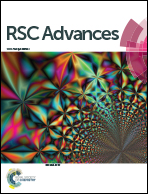Dual-stimuli-responsive glycopolymer bearing a reductive and photo-cleavable unit at block junction
Abstract
New dual-stimuli-responsive and bio-recognizable glycopolymers (Glyco-ONB-s-s-PXCL) containing a photodegradable 5-hydroxy-2-nitrobenzyl alcohol (ONB), and a redox-cleavable disulfide (-s-s-) as junction point between bio-recognizable hydrophilic sugar molecule (Glyco) and hydrophobic poly(4-substituted-ε-caprolactone) (PXCL) chains were synthesized using a combination of ring-opening polymerization and nucleophilic substitution reactions. When the polymer solution was exposed to ultraviolet (UV) irradiation and/or the reducing agent DL-dithiothreitol (DTT), substantial structural and morphological changes were observed in the particles. The polymers formed micelles in the aqueous solution, had hydrodynamic sizes ≤200 nm, and were spherical. Under the combined stimulation of UV irradiation and DTT, the micellar nanoparticles dissociated and the loaded molecules could be released from the assemblies more efficiently than under the stimulation of only one of the two stimuli. Selective lectin binding experiments confirmed that glucosylated Gluco-ONB-s-s-PXCL can be used for bio-recognition. The nanoparticles exhibited nonsignificant toxicity against HeLa cells at concentrations of ≤300 μg mL−1. The DOX-loaded Gluco-ONB-s-s-PMCL20 micelles effectively inhibited the proliferation of HeLa cells with a half-maximal inhibitory concentration (IC50) of 1.5 μg mL−1.


 Please wait while we load your content...
Please wait while we load your content...